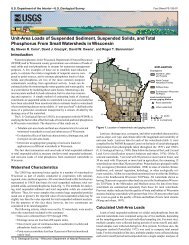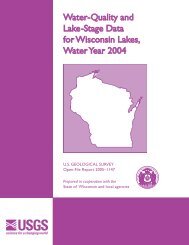The Effects of Large-Scale Pumping and Diversion on ... - Wisconsin
The Effects of Large-Scale Pumping and Diversion on ... - Wisconsin
The Effects of Large-Scale Pumping and Diversion on ... - Wisconsin
Create successful ePaper yourself
Turn your PDF publications into a flip-book with our unique Google optimized e-Paper software.
In order to improve the underst<str<strong>on</strong>g>and</str<strong>on</strong>g>ing <str<strong>on</strong>g>of</str<strong>on</strong>g> the hydrologic system <str<strong>on</strong>g>and</str<strong>on</strong>g> the<br />
effects <str<strong>on</strong>g>of</str<strong>on</strong>g> increased ground-water use, a Dane County Regi<strong>on</strong>al Hydrologic<br />
Study was initiated. <str<strong>on</strong>g>The</str<strong>on</strong>g> study was a cooperative effort am<strong>on</strong>g the<br />
Dane County Regi<strong>on</strong>al Planning Commissi<strong>on</strong>, the Wisc<strong>on</strong>sin Geological<br />
<str<strong>on</strong>g>and</str<strong>on</strong>g> Nati<strong>on</strong>al History Survey, <str<strong>on</strong>g>and</str<strong>on</strong>g> the U.S. Geological Survey. <str<strong>on</strong>g>The</str<strong>on</strong>g> study<br />
included the development <str<strong>on</strong>g>of</str<strong>on</strong>g> a regi<strong>on</strong>al ground-water flow model, which<br />
helps managers make informed water-resources decisi<strong>on</strong>s <strong>on</strong> an <strong>on</strong>going<br />
basis. <str<strong>on</strong>g>The</str<strong>on</strong>g> model helped identify major areas <str<strong>on</strong>g>of</str<strong>on</strong>g> ground-water recharge <str<strong>on</strong>g>and</str<strong>on</strong>g><br />
discharge, estimate the amount <str<strong>on</strong>g>of</str<strong>on</strong>g> ground water discharging to surfacewater<br />
bodies, <str<strong>on</strong>g>and</str<strong>on</strong>g> simulate ground-water flow directi<strong>on</strong> <str<strong>on</strong>g>and</str<strong>on</strong>g> rates. Once the<br />
model was developed, it was used for assessing effects <str<strong>on</strong>g>of</str<strong>on</strong>g> future groundwater<br />
withdrawals <str<strong>on</strong>g>and</str<strong>on</strong>g> the effects <str<strong>on</strong>g>of</str<strong>on</strong>g> proposed water-management programs.<br />
<str<strong>on</strong>g>The</str<strong>on</strong>g> initial model was completed in 1995 <str<strong>on</strong>g>and</str<strong>on</strong>g> has been updated<br />
annually to incorporate current c<strong>on</strong>diti<strong>on</strong>s <str<strong>on</strong>g>and</str<strong>on</strong>g> updated modeling codes<br />
<str<strong>on</strong>g>and</str<strong>on</strong>g> procedures. <str<strong>on</strong>g>The</str<strong>on</strong>g> purpose <str<strong>on</strong>g>of</str<strong>on</strong>g> this Fact Sheet is to describe how the<br />
model was developed <str<strong>on</strong>g>and</str<strong>on</strong>g> used.<br />
How ground-water flow models work<br />
Underst<str<strong>on</strong>g>and</str<strong>on</strong>g>ing the ground-water-flow system can be difficult, so investigators<br />
comm<strong>on</strong>ly use mathematical models to simulate a simplified<br />
versi<strong>on</strong> <str<strong>on</strong>g>of</str<strong>on</strong>g> the system using computers. <str<strong>on</strong>g>The</str<strong>on</strong>g> computer code relies <strong>on</strong> two<br />
basic principles to perform simulati<strong>on</strong>s. <str<strong>on</strong>g>The</str<strong>on</strong>g> first is that water flows<br />
“downhill,” or more exactly, from high potential to low potential. <str<strong>on</strong>g>The</str<strong>on</strong>g><br />
sec<strong>on</strong>d principle is that water cannot be created or destroyed; thus, what<br />
flows into the ground-water system must either flow out or be stored.<br />
Changes in storage are identified by changes in water levels within the<br />
system. Using these principles, as well as site geology <str<strong>on</strong>g>and</str<strong>on</strong>g> locati<strong>on</strong>s <str<strong>on</strong>g>of</str<strong>on</strong>g><br />
streams <str<strong>on</strong>g>and</str<strong>on</strong>g> lakes in the area being studied, the hydrologic system is<br />
simplified <str<strong>on</strong>g>and</str<strong>on</strong>g> represented in a mathematical model. It should be noted<br />
that, whereas seemingly simple in principle <str<strong>on</strong>g>and</str<strong>on</strong>g> operati<strong>on</strong>, ground-water<br />
modeling can be complex because <str<strong>on</strong>g>of</str<strong>on</strong>g> uncertainty in important model<br />
inputs such as properties <str<strong>on</strong>g>of</str<strong>on</strong>g> the material in the subsurface <str<strong>on</strong>g>and</str<strong>on</strong>g> timing <str<strong>on</strong>g>of</str<strong>on</strong>g><br />
water additi<strong>on</strong>s <str<strong>on</strong>g>and</str<strong>on</strong>g> subtracti<strong>on</strong>s.<br />
Model calibrati<strong>on</strong><br />
<str<strong>on</strong>g>The</str<strong>on</strong>g> ground-water flow model for the Dane County area was developed<br />
using the computer program MODFLOW (McD<strong>on</strong>ald <str<strong>on</strong>g>and</str<strong>on</strong>g> Harbaugh,<br />
1988). <str<strong>on</strong>g>The</str<strong>on</strong>g> model inputs included such variables as the amount <str<strong>on</strong>g>of</str<strong>on</strong>g> rain <str<strong>on</strong>g>and</str<strong>on</strong>g><br />
snow that enters the ground-water system (that is, the amount <str<strong>on</strong>g>of</str<strong>on</strong>g> precipitati<strong>on</strong><br />
minus the amount <str<strong>on</strong>g>of</str<strong>on</strong>g> run<str<strong>on</strong>g>of</str<strong>on</strong>g>f to streams <str<strong>on</strong>g>and</str<strong>on</strong>g> the amount removed by<br />
evaporati<strong>on</strong> <str<strong>on</strong>g>and</str<strong>on</strong>g> plant uptake). In additi<strong>on</strong>, the locati<strong>on</strong>s <str<strong>on</strong>g>of</str<strong>on</strong>g> large wells,<br />
streams, <str<strong>on</strong>g>and</str<strong>on</strong>g> lakes in Dane County were entered into the model. <str<strong>on</strong>g>The</str<strong>on</strong>g> model<br />
was calibrated using 1992 pumping rates, <str<strong>on</strong>g>and</str<strong>on</strong>g> simulated ground-water<br />
levels <str<strong>on</strong>g>and</str<strong>on</strong>g> flows to or from the streams were compared to the ground-water<br />
levels <str<strong>on</strong>g>and</str<strong>on</strong>g> flows measured in the study area. Using a trial-<str<strong>on</strong>g>and</str<strong>on</strong>g>-error<br />
Important surface-water features can be affected by ground-water pumping. One<br />
such feature is the Pheasant Branch spring shown above.<br />
A<br />
B<br />
0 5 10 MILES<br />
0 5 10 KILOMETERS<br />
Fish <str<strong>on</strong>g>and</str<strong>on</strong>g> Crystal Lakes<br />
Pheasant Branch<br />
Springs<br />
Yahara lakes<br />
City <str<strong>on</strong>g>of</str<strong>on</strong>g> Madis<strong>on</strong><br />
Nine Springs<br />
area<br />
Figures 1a <str<strong>on</strong>g>and</str<strong>on</strong>g> 1b. Simulated drawdown from pre-development c<strong>on</strong>diti<strong>on</strong>s in<br />
the upper bedrock (fig. 1a) <str<strong>on</strong>g>and</str<strong>on</strong>g> Mount Sim<strong>on</strong> (fig. 1b) aquifers resulting from<br />
high-capacity pumping at typical 1992 discharge rates. <str<strong>on</strong>g>The</str<strong>on</strong>g> Yahara lakes<br />
supply water to the wells, which splits the drawdown into two distinct c<strong>on</strong>es<br />
<str<strong>on</strong>g>of</str<strong>on</strong>g> depressi<strong>on</strong>. C<strong>on</strong>tour interval is 10 feet.<br />
approach, the various model inputs were varied until model-simulated<br />
levels <str<strong>on</strong>g>and</str<strong>on</strong>g> flow approximated measured values. Measured-to-simulated<br />
ground-water levels from over 3,000 wells <str<strong>on</strong>g>and</str<strong>on</strong>g> measured-to-simulated<br />
flows in 13 streams were compared during the model calibrati<strong>on</strong> process.<br />
Model results: comparis<strong>on</strong> <str<strong>on</strong>g>of</str<strong>on</strong>g> pre-development<br />
c<strong>on</strong>diti<strong>on</strong>s to current c<strong>on</strong>diti<strong>on</strong>s<br />
Drawdown,<br />
in feet<br />
Pre-development c<strong>on</strong>diti<strong>on</strong>s were simulated by removing the pumping<br />
wells from the calibrated base model. This resulted in a representati<strong>on</strong> <str<strong>on</strong>g>of</str<strong>on</strong>g><br />
the hydrologic system before development that can be compared to current<br />
c<strong>on</strong>diti<strong>on</strong>s to assess the effects <str<strong>on</strong>g>of</str<strong>on</strong>g> pumping <strong>on</strong> water resources.<br />
As shown by c<strong>on</strong>touring the simulated drawdown (the amount <str<strong>on</strong>g>of</str<strong>on</strong>g> waterlevel<br />
decline from predevelopment c<strong>on</strong>diti<strong>on</strong>s caused by the pumping), the<br />
greatest effect <str<strong>on</strong>g>of</str<strong>on</strong>g> pumping <strong>on</strong> water levels results in the Madis<strong>on</strong> metropolitan<br />
area. Shallow <str<strong>on</strong>g>and</str<strong>on</strong>g> deep ground-water levels in the vicinity <str<strong>on</strong>g>of</str<strong>on</strong>g> Madis<strong>on</strong><br />
declined more than 60 feet (fig. 1a <str<strong>on</strong>g>and</str<strong>on</strong>g> 1b). <str<strong>on</strong>g>The</str<strong>on</strong>g> largest declines are at the<br />
centers <str<strong>on</strong>g>of</str<strong>on</strong>g> two c<strong>on</strong>es <str<strong>on</strong>g>of</str<strong>on</strong>g> depressi<strong>on</strong> that are split by the Madis<strong>on</strong> lakes.<br />
Directly adjacent to <str<strong>on</strong>g>and</str<strong>on</strong>g> beneath these lakes there is no simulated drawdown<br />
<str<strong>on</strong>g>of</str<strong>on</strong>g> the water table <str<strong>on</strong>g>and</str<strong>on</strong>g> <strong>on</strong>ly about 10 feet <str<strong>on</strong>g>of</str<strong>on</strong>g> drawdown simulated in<br />
the Mt. Sim<strong>on</strong> aquifer. Two distinct c<strong>on</strong>es <str<strong>on</strong>g>of</str<strong>on</strong>g> depressi<strong>on</strong> indicate that these<br />
lakes are important sources <str<strong>on</strong>g>of</str<strong>on</strong>g> water to the pumping wells. This result is<br />
expected because the c<strong>on</strong>fining unit is absent or thin in this area <str<strong>on</strong>g>and</str<strong>on</strong>g> the<br />
aquifers are in good hydraulic c<strong>on</strong>necti<strong>on</strong> with the lakes.<br />
It is interesting to note that prior to the large-scale pumping <str<strong>on</strong>g>and</str<strong>on</strong>g><br />
diversi<strong>on</strong> associated with development, the lakes <str<strong>on</strong>g>and</str<strong>on</strong>g> wetl<str<strong>on</strong>g>and</str<strong>on</strong>g>s within the<br />
Madis<strong>on</strong> area primarily received ground water. <str<strong>on</strong>g>The</str<strong>on</strong>g>se lakes <str<strong>on</strong>g>and</str<strong>on</strong>g> wetl<str<strong>on</strong>g>and</str<strong>on</strong>g>s<br />
primarily lose water to the ground-water system as a result <str<strong>on</strong>g>of</str<strong>on</strong>g> present-day<br />
pumping <str<strong>on</strong>g>and</str<strong>on</strong>g> diversi<strong>on</strong> (fig. 2). Moreover, the largest area where ground<br />
10<br />
20<br />
30<br />
40<br />
50<br />
60








